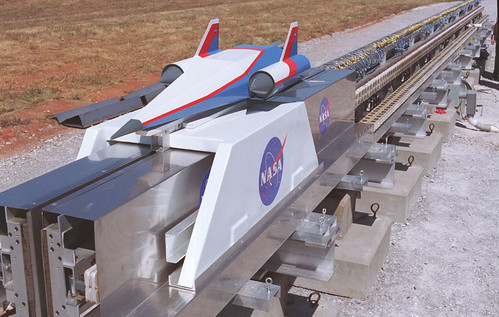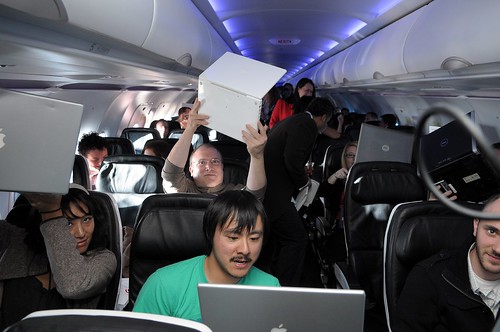STS-133 Launch Day
Thursday, February 24th, 2011

Launch looks like a "go" for today, at 21:50 GMT. Watch it live on SpaceFlightNow.com, NASA TV and coverage on HDnet begins at 4:30.

Launch looks like a "go" for today, at 21:50 GMT. Watch it live on SpaceFlightNow.com, NASA TV and coverage on HDnet begins at 4:30.
Dosvedanya Mio Bombino: Musical best wishes to astronauts Paolo & Aleksandr for ATV docking from Daniel Scuka on Vimeo.
Nice mashup by the ESA.
Seattle, USA-based band Pink Martini have sent in a fantastic video greeting for the entire ISS crew and especially ESA astronaut Paolo Nespoli, from Italy, and Russian cosmonaut Aleksandr Kaleri as they get ready for today’s ATV Johannes Kepler docking. Lead singer China Forbes sends the group’s best wishes and she’s dedicated one of their favourite tracks, Dosvedanya Mio Bombino – a song about Russia and Italy – to the two astros in space. We’ve mashed up her greeting with some recent ISS and ATV footage, which we hope you’ll enjoy. Thanks, China, and thanks to everyone at Pink Martini for your support and encouragement! Music, Lyrics Copyright (C) Pink Martini – used with permission.

NASA JSC’s Robonaut-2 is mostly all business. JAXA’s HRP-4C is chatty and more communicative. Tweets, too.
Well, Robonaut-2’s been Tweeting already, so that’s not new. But can he sing? Not like this…
NASA’s Stardust-NExT: Valentine’s Night Comet Flyby.
How did they do that? Math, kids. It’s all in the math.

Looks like the STS-133 launch is slipping to the end of the month, after engineers found a crack in the external fuel tank:
Cracked foam insulation on the shuttle Discovery’s external tank was cut away overnight, revealing serpentine cracks in an underlying structural rib, or stringer. Based on experience repairing similar cracks on other tanks, sources said, engineers believe the damage can be fixed at the pad before the next launch window opens at the end of the month.
Follow the news — and live launch — on Spaceflight Now.

Yeah, we got plenty of Milky Ways left in the Halloween candy bank. How fitting today’s Astronomy Picture of the Day includes the Milky Way:
On Reunion Island, it is known simply as "The Volcano." To others, it is known as the Piton de la Fournaise, which is French for the Peak of the Furnace. It is one of the most active volcanoes in the world. The Volcano started a new eruption last month by spewing hot lava bombs as high as 10 meters into the air from several vents. Pictured above, the recent eruption was caught before a star filled southern sky, appearing somehow contained beneath the arching band of our Milky Way Galaxy. Also visible in the background sky is the Pleiades open star cluster, the constellation of Orion, the brightest star Sirius, and the neighboring Large and Small Magellanic Cloud galaxies. (Can you find them?) The Piton de la Fournaise erupted for months in 2006, and for days in 2007, 2008, and in January of 2010. Nobody knows how long the current eruption will last, or when The Volcano will erupt next.
Photo by Luc Perrot.

Using a giant electromagnetic rail system to launch scramjets to near-space, after which a second-stage type engine fires to reach orbit, is something we can expect to see after further development get it a practical level. If this type of system reduces overall launch costs, it would be a very good thing, as rocket-based launch systems can concentrate on getting bigger payloads into geo.
An early proposal has emerged that calls for a wedge-shaped aircraft with scramjets to be launched horizontally on an electrified track or gas-powered sled. The aircraft would fly up to Mach 10, using the scramjets and wings to lift it to the upper reaches of the atmosphere where a small payload canister or capsule similar to a rocket’s second stage would fire off the back of the aircraft and into orbit. The aircraft would come back and land on a runway by the launch site.
Engineers also contend the system, with its advanced technologies, will benefit the nation’s high-tech industry by perfecting technologies that would make more efficient commuter rail systems, better batteries for cars and trucks, and numerous other spinoffs.
It might read as the latest in a series of science fiction articles, but NASA’s Stan Starr, branch chief of the Applied Physics Laboratory at Kennedy, points out that nothing in the design calls for brand-new technology to be developed. However, the system counts on a number of existing technologies to be pushed forward.
"All of these are technology components that have already been developed or studied," Starr said. "We’re just proposing to mature these technologies to a useful level, well past the level they’ve already been taken."
We love the scramjet, wihich will likely beat out other ideas, such as the "space gun."But wait a minute. Didn’t Prof. Potts experiment with rail launchers? Indeed, here it is…
Cobbet Hill earthstation expands satellite services in Europe, Middle East, and Africa with purchase of third iDirect Evolution hub.
[PR Newswire – 09/11/2010]
Arianespace signs production contract with European Space Agency to produce first operational Vega rocket launch; will deliver five launchers.
[Satellite Today – 09/10/2010]
CBS’s Stranathan believes the evolution from satellite back to terrestrial may begin within the next five years, with multiple carriers and growth of fiber-optic networks nationwide.
[Satellite Today – 09-10-2010]

Row 44 raises $37m in funding to continue rolling out its in-flight satellite service for Southwest Airlines.
[Satellite Today – 09/10/2010]
SIDOFI Communications Investments, Ltd. plans to acquire a 9.33% stake in Asianet Satellite Communications, Ltd., an India-based cable network services company, from Americorp Ventures Limited.
[Trading Markets – 09/10/2010]
Focus on "the next big thing" at IBC 2010 continues to be 3-D.
[Satellite Today – 09/10/2010]
Iridium announces that Norbulk Shipping will install Iridium’s OpenPort systems across its fleet of more than 70 ships.
[Satellite Spotlight – 09/10/2010]
Astrium leases Hylas 1 capacity to test military Ka-band services.
[Satellite Today – 09/09/2010]
KVH offers Premier Support 24 X 7 X 365 for owners of vessels with the TracPhone V7 satellite communications system.
[Trading Markets – 09/10/2010]
RRsat partners with BT to deliver first intercontinental interactive 3D video broadcast between London and Tel Aviv.
[Market Watch – 09/10/2010]
Russian Rokot orbits a Gonets-M satellite and two Kosmos satellites according to Russian Defense Ministry spokesman.
[SatNews – 09/09/2010]
Via Embratel adopts Entropic’s Channel Stacking Swtich technology, to better serve customers in multiple-dwelling unit (MDU) environments by supporting multiple tuners over a single cable.
[Market Watch – 09/09/2010]
Space Exploration Technologies (SpaceX) and Astrium engage in commercial agreement to provide dedicated launch services to European small satellite market.
[SatNews – 09/09/2010]
The satellite sector of the economy has ridden through the collapse of the economy well and business now looks to be booming, though warning flags exist.
[Satellite Today – 09/09/2010
SES WORLD SKIES gets extension from Services Sound and Vision Corporation to continue delivering television and radio programming to British troops around the world.
[SatNews – 09/09/2010]
Military and commercial wideband satellites to provide broader coverage and address bandwidth surge, transforming battlefield communications.
[Defensesystems – 09/09/2010]
SES ASTRA and Digitaria create nationwide energy monitoring system in Italy using Newtec’s Sat3Play technology for connecting remote sites.
[SatNews – 09/09/2010]
Bell Canada is on the verge of a major effort to get inside Canadian family rooms with the introduction of new Internet-based TV services.
[The Vancouver Sun – 09/10/2010]
Wegener receives order for receivers to be used in expansion of international background music network.
[Market Watch – 09/09/2010].
Euroconsult releases report forecasting the number of satellites it expects to be launched by the end of the decade – 1,220 satellites.
[BBC Spaceman blog – 09/09/2010]
Intelsat is expanding Russian DTH satellite provider Orion Express’ programming capacity on the Intelsat 15 satellite.
[Satellite Today – 09/09/2010]
RRsat enters into partnership with Europe’s Digital Media Center (DMC) to offer a complete global playout and content delivery solutions to regional broadcasters.
[Satellite Today – 09/09/2010]
Hughes Communications receives Euroconsult award as Broadband Satellite Operator of the Year.
[Market Watch – 09/08/2010]
SES extends its Multi Launch Agreement with International Launch Services through the end of 2014.
[Satellite Today – 09/08/2010]
SES ASTRA signs new service distribution agreement with Amman, Jordan-based satellite services provider, GSISCO (German Satellite Internet Service Company) to market its ASTRA2Connect service in Iraq, Jordan, Lebanon, and Yemen.
[SatNews – 09/08/2010]
Sky Deutschland to launch 3-D satellite service in October.
[Satellite Today – 09/08/2010]
KVH to acquire software engineering company Virtek Communications.
[Market Watch – 09/08/2010]
Comtech Mobile Datacom receives $25m military contract.
[Business Week – 09/08/2010]
Harmonic encoders and statistical multiplexing implemented in headend for new South African pay TV service.
[Market Watch – 09/08/2010]
Gilat is selected by Kenya Commercial Bank to provide SkyEdge II broadband satellite network.
[SatNews – 09/08/2010]
Iridium collaborates with Danish Maritime Safety Administration in project to demonstrate maritime safety information broadcasts.
[Market Watch – 09/08/2010]
Comtech and CPI announce termination of agreement and plan of merger.
[SatNews – 09/08/25010]
Global VSAT Forum launches Maritime Satcom Forum to expand deployment of satellite technology in the maritime industry.
[PR Newswire – 09/08/2010]

Stratos Global successfully deploys Inmarsat FleetBroadband satellite communications service on the entire fleet of 70 container vessels for Evergreen Marine Corp.
[SatNews – 09/08/2010]
Lockheed Martin is selected by GeoEye to launch the company’s next generation high-resolution Earth-imaging satellite, GeoEye-2.
[SatNews – 09/08/2010]
European scientific satellite Ocean Circulation Explorer fixed and again transmitting data.
[UPI – 09/07/2010]
Canadian satellite company Com Dev dismisses its CEO after heavy losses in Q3 2010.
[Satellite Today – 09/07/2010]
Telefonica International Wholesale Services of Peru chooses Gilat for broadband satellite communications network.
[Market Watch – 09/07/2010]
Spanish broadband company Quantis is rolling out full-service broadband solution to remote and rural communities across Spain based on Newtec’s Ka-band Sat3Play technology, hub, and terminals.
[Satellite Today – 09/07/2010]
VIVACOM, the leading telecommunications provider in Bulgaria, signs multi-year multi-transponder contract for capacity on Intelsat 12 satellite.
[SatNews – 09/07/2010]
U.S. Army awards TeleCommunications Systems up to $3.8m for deployable satellite systems equipment.
[Market Watch – 09/07/2010]
Europe Media Port announces that emerging Iranian DTH broadcaster Kahkeshan Digisat has selected EMP to provide DTH uplink teleport and transmission services to its European and Middle East targeted markets.
[SatNews – 09/07/2010]
StreamXcel Plus switching between satellite networks promises "always on" connectivity to shipping vessels.
[TMCnet – 09/07/2010]
In the fourth launch in five weeks, Chinese broadcasting satellite is placed in orbit.
[Space.com – 09/07/2010]
Spain and Norway to build a satellite to be launched in 2014 to be used for both civilian and military purposes.
[physorg.com – 09/07/2010]
Stratos Global joins forces with new Channel Partner, Zedi Inc., to deploy the world’s first large-scale SCADA network based on Inmarsat’s BGAN mobile broadband satellite service.
[SatNews – 09/07/2010]
American company Orbital Sciences begins production of first national telecommunications satellite of Azerbaijan.
[Azerbaijan Business Center – 09/07/2010]
Long-standing Cobham dealer Ship Equip. places the largest single quantity order ever received for the company’s Sea Tel 09 series antennas.
[SatNews – 09/07/2010]
GE Satcom uses Newtec’s TelliCast IP software to power its maritime triple-play service.
[SatNews – 09/07/2010]

Nice work by the Kepler Mission scientists, announced last week:
NASA’s Kepler spacecraft has discovered the first confirmed planetary system with more than one planet crossing in front of, or transiting, the same star.
The transit signatures of two distinct planets were seen in the data for the sun-like star designated Kepler-9. The planets were named Kepler-9b and 9c. The discovery incorporates seven months of observations of more than 156,000 stars as part of an ongoing search for Earth-sized planets outside our solar system. The findings will be published in Thursday’s issue of the journal Science.
Kepler’s ultra-precise camera measures tiny decreases in the stars’ brightness that occur when a planet transits them. The size of the planet can be derived from these temporary dips.
The distance of the planet from the star can be calculated by measuring the time between successive dips as the planet orbits the star. Small variations in the regularity of these dips can be used to determine the masses of planets and detect other non-transiting planets in the system.
In June, mission scientists submitted findings for peer review that identified more than 700 planet candidates in the first 43 days of Kepler data. The data included five additional candidate systems that appear to exhibit more than one transiting planet. The Kepler team recently identified a sixth target exhibiting multiple transits and accumulated enough follow-up data to confirm this multi-planet system.
"Kepler’s high quality data and round-the-clock coverage of transiting objects enable a whole host of unique measurements to be made of the parent stars and their planetary systems," said Doug Hudgins, the Kepler program scientist at NASA Headquarters in Washington.
Scientists refined the estimates of the masses of the planets using observations from the W.M. Keck Observatory in Hawaii. The observations show Kepler-9b is the larger of the two planets, and both have masses similar to but less than Saturn. Kepler-9b lies closest to the star with an orbit of about 19 days, while Kepler-9c has an orbit of about 38 days. By observing several transits by each planet over the seven months of data, the time between successive transits could be analyzed.
"This discovery is the first clear detection of significant changes in the intervals from one planetary transit to the next, what we call transit timing variations," said Matthew Holman, a Kepler mission scientist from the Harvard-Smithsonian Center for Astrophysics in Cambridge, Mass. "This is evidence of the gravitational interaction between the two planets as seen by the Kepler spacecraft."
In addition to the two confirmed giant planets, Kepler scientists also have identified what appears to be a third, much smaller transit signature in the observations of Kepler-9. That signature is consistent with the transits of a super-Earth-sized planet about 1.5 times the radius of Earth in a scorching, near-sun 1.6 day-orbit. Additional observations are required to determine whether this signal is indeed a planet or an astronomical phenomenon that mimics the appearance of a transit.
More about the mission in this video…

According to Professor Fitts of Marquette University, astronauts need to stay fit while they travel to Mars. Tom Held’s piece in today’s Milwaukee Journal Sentinel is worth reading…
Over five years, the MU professor and his team analyzed muscle biopsies taken from nine astronauts and cosmonauts before and after their six-month missions on the International Space Station. Their muscles atrophied and lost power significantly, despite regular workouts on a treadmill and resistance machine.
The lack of gravitational force to stress the muscles continues to be a problem.
“The muscle is being activated, but there is no load,” said Fitts, chairman of the Department of Biological Sciences at Marquette.
“The exercises are not adequate at the moment,” he said. “We showed that treadmill running was more effective than biking in protecting against muscle loss, but it’s still not good enough.”
Fitts has been studying the physical effects of prolonged space flight for nearly two decades, starting with analysis of muscle loss during the shorter space shuttle flights. The results of those studies guided the nutritional and exercise plans implemented by astronauts on longer missions, and the new findings will be vital if the U.S. pursues manned missions to Mars.
The paper published in the Journal of Physiology provides an in-depth analysis of 2,000 muscle fibers sampled from the calves of astronauts and cosmonauts who spent six months on the space station. Their missions were spread from 2000 to 2005.
Fitts found the muscles suffered a 35% loss of force and a 20% loss of size in the slow-twitch fibers. The loss of power – the key to movement – was roughly 45%.
“The biggest problem is the wasting of the muscle and the reduction of the motion, and as a result the power loss is much greater than the atrophy,” Fitts said.
“The danger would be in an emergency,” he said. “If there was an emergency on landing, they wouldn’t be able to egress out of the vehicle rapidly.”
Equally problematic is the loss of stamina. Astronauts attempting space walks or other operations after months in a low-gravity environment would fatigue quickly, limiting their capacity to work.